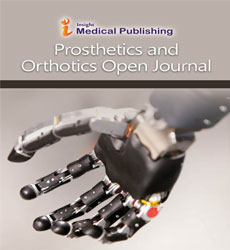Usage of Pedorthics in Managing Diabetic Foot
Swagatika Mishra*
Department of Prosthetics and Orthotics, MGM Medical College and Hospital, Navi Mumbai, India
- Corresponding Author:
- Swagatika Mishra
Associate Professor, Department of Prosthetics and Orthotics
MGM Medical College and Hospital, Sec-1
Kamothe, Navi Mumbai-410209, India
Tel: +91-8691880410
E-mail: mswagatika@gmail.com
Received Date: October 19, 2016; Accepted Date: November 03, 2016; Published Date: November 07, 2016
Citation: Swagatika Mishra (2016) Usage of Pedorthics in Managing Diabetic Foot. Pro Ort Open J 1:1.
Copyright: © 2016 Mishra S. This is an open-access article distributed under the terms of the Creative Commons Attribution License, which permits unrestricted use, distribution, and reproduction in any medium, provided the original author and source are credited.
Letter to Editor
Diabetes is no more the developed countries disease, it has spread its roots equally in the developing country, like in India. Diabetes and its complications are now rapidly becoming the second threat to human longevity. There are different types of diabetes, but the common affected areas in all cases start with the foot. The insensate foot leads to the largest trend of amputation.
Abnormal pressure on the insensate foot plays an important role in the pathogenesis of diabetic foot ulcers. Failure to relieve pressure is the main cause of non-healing diabetic ulcers. Generally, people on a common note feel that wearing footwear prevents and cures diabetes. But different studies have shown that about 83% of diabetic subjects did not wear appropriate footwear. The common foot disorders start with the collapse of the normal foot arch or generally referred to as the flat foot type. The biomechanics gets altered and hence, leads to callus formation in the classic diabetic callus formation style, i.e., 1st metatarsal callus, 5th metatarsal callus, Hallux valgus with 1st metatarsal callus, callus halux IP joint etc. These are generally neglected by people at the preventive stage hence; they report these features at the surgical centre when they start suffering from non-healing ulcers, thereby increasing the risk of losing their metatarsals.
Adequate pressure relief is important both for the healing of ulcers and even after healing to prevent recurrence. Pedorthics works on the goal of promoting patients, an active lifestyle while supporting them and training them biomechanically, regarding their injury, deformity and wound healing. Pedorthics includes the wide range of extra depth shoes, insoles with modifications, silicone insoles, wide toe box shoes, shoes with metatarsal bar, bunion pads, hallux valgus splinting within the shoe etc. The main goal of Pedorthics, in diabetic foot management, is to have sufficient space to allow a simple or specialized insole to be placed, and to have space to ensure that the dorsum of toes are not pushed against the upper of the shoe.
Pedorthics enforces that individuals should be educated and encouraged to have a lifestyle that includes exercise along with varied daily activities that promote aerobic health and functional fitness. An annual foot exam and necessary follow-up that includes functional lower extremity biomechanics should be made mandatory at regular intervals.

Open Access Journals
- Aquaculture & Veterinary Science
- Chemistry & Chemical Sciences
- Clinical Sciences
- Engineering
- General Science
- Genetics & Molecular Biology
- Health Care & Nursing
- Immunology & Microbiology
- Materials Science
- Mathematics & Physics
- Medical Sciences
- Neurology & Psychiatry
- Oncology & Cancer Science
- Pharmaceutical Sciences
